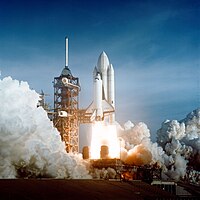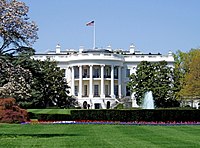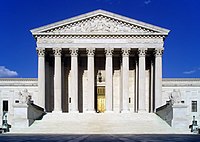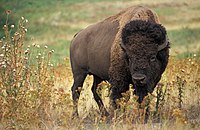MarshalN20 (talk | contribs) |
MarshalN20 (talk | contribs) |
||
| Line 127: | Line 127: | ||
| direction = vertical |
| direction = vertical |
||
| image1 = |
| image1 = Battle of Franklin, November 30, 1864.jpg |
||
| alt1 = Yellow cartouche |
| alt1 = Yellow cartouche |
||
| width1 = 200 |
| width1 = 200 |
||
| Line 139: | Line 139: | ||
}} |
}} |
||
{{clear}} |
{{clear}} |
||
==Government== |
==Government== |
||
{{Main|Federal government of the United States|state governments of the United States|elections in the United States}} |
{{Main|Federal government of the United States|state governments of the United States|elections in the United States}} |
||
Revision as of 15:27, 3 July 2014
United States of America | |
|---|---|
| Motto: | |
| Anthem: "The Star-Spangled Banner" | |
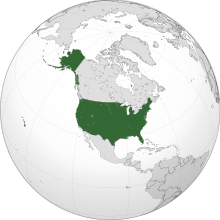 | |
| Capital | Washington, D.C. |
| Largest city | New York City |
| Official languages | None at federal level[a] |
| National language | American English[b] |
| Demonym(s) | American |
| Government | Federal presidential constitutional republic |
| Barack Obama (D) | |
| Joe Biden (D) | |
| John Boehner (R) | |
| John Roberts | |
| Legislature | Congress |
| Senate | |
| House of Representatives | |
| Independence from Great Britain | |
• Declared | July 4, 1776 |
| September 3, 1783 | |
| June 21, 1788 | |
| Area | |
• Total | 9,826,675 km2 (3,794,100 sq mi)[4][c] (3rd/4th) |
• Water (%) | 6.76 |
| Population | |
• 2013 estimate | 336,565,000[5] (3rd) |
• Density | 34.2/km2 (88.6/sq mi) (179th) |
| GDP (PPP) | 2013 estimate |
• Total | $16.724 trillion[6] (1st) |
• Per capita | $52,839[6] (6th) |
| GDP (nominal) | 2013 estimate |
• Total | $16.724 trillion[6] (1st) |
• Per capita | $52,839[6] (9th) |
| Gini (2011) | 47.7[7] high (39th (2009)) |
| HDI (2013) | very high (3rd) |
| Currency | [[]] ($) (USD) |
| Time zone | UTC−5 to −10 |
• Summer (DST) | UTC−4 to −10[e] |
| Driving side | right[g] |
| Calling code | +1 |
| ISO 3166 code | US |
| Internet TLD | .us .gov .mil .edu |
| |
The United States, officially the United States of America, is a country in northern North America. Its contiguous territory is bordered in the north by Canada, in the south by Mexico, in the west by the Pacific Ocean, and in the east by the Atlantic Ocean. Its non-contiguous territory extends the country's borders worldwide. At 4 square miles (9.83 square kilometres) in total, the United States is the fourth-largest country by total area.
The U.S. mainland was originally inhabited by various Native American civilizations. Europeans colonized the region beginning in the 16th century. After obtaining independence from Great Britain in 1783, the United States developed into a major regional power in the Western Hemisphere, and underwent territorial expansion under the doctrine of manifest destiny. The territorial integrity of the state was consolidated following a civil war, and the U.S. thereafter entered a Gilded Age of increasing industrialization, immigration, and social reform. In the twentieth century, the country's leading role in two world wars confirmed its status as a global superpower and a permanent member of the United Nations Security Council. After the end of a decades-long Cold War with the Soviet Union, the United States became the world's foremost economic, military, and technological power.
The United States is a federal republic divided into 50 states, 16 territories, a federal district, and various overseas extraterritorial jurisdictions. Its diverse geography include the vast Interior Plains, arctic Alaska, tropical Hawaii, the valleys of its Appalachian highlands, and the arid deserts of its Southwest. It is a developed country with a very high Human Development Index. Its national economy is the world's largest, and it is fueled by an abundance of natural resources, a well-developed infrastructure, and a large manufacturing sector.
The U.S. population, estimated at 316 million, is the third largest in the world. Americans are multiethnic and multicultural, the product of large-scale immigration. The main spoken language is English, and a significant number of the nation's inhabitants also speak Spanish. At the forefront of its national identity, the U.S. has traditionally upheld the ideals of freedom, democracy, and opportunity.
Etymology
In 1507, the German cartographer Martin Waldseemüller produced a world map on which he named the lands of the Western Hemisphere "America" after the Italian explorer and cartographer Amerigo Vespucci.[11]
The first documentary evidence of the phrase "United States of America" is from a letter dated January 2, 1776, written by Stephen Moylan, Esq., George Washingon's aide-de-camp and Muster-Master General of the Continental Army. Addressed to Lt. Col. Joseph Reed, Moylan expressed his wish to carry the "full and ample powers of the United States of America" to Spain to assist in the revolutionary war effort.[12]
The first publicly published evidence of the phrase "United States of America" was in an anonymously written essay in The Virginia Gazette newspaper in Williamsburg, Virginia, on April 6, 1776.[13][14] In June 1776, Thomas Jefferson included the phrase "UNITED STATES OF AMERICA" in all capitalized letters in the headline of his "original Rough draught" of the Declaration of Independence.[15][16] In the final Fourth of July version of the Declaration, the pertinent section of the title was changed to read, "The unanimous Declaration of the thirteen united States of America".[17]
In 1777 the Articles of Confederation announced, "The Stile of this Confederacy shall be 'The United States of America'".[18]
The short form "United States" is also standard. Other common forms include the "U.S.", the "USA", and "America". Colloquial names include the "U.S. of A." and, internationally, the "States". "Columbia", a name popular in poetry and songs of the late 1700s,[19] derives its origin from Christopher Columbus; it appears in the name "District of Columbia".
The standard way to refer to a citizen of the United States is as an "American". "United States", "American" and "U.S." are used to refer to the country adjectivally ("American values", "U.S. forces"). "American" is rarely used in English to refer to subjects not connected with the United States.[20]
The phrase "United States" was originally treated as plural, a description of a collection of independent states—e.g., "the United States are"—including in the Thirteenth Amendment to the United States Constitution, ratified in 1865. It became common to treat it as singular, a single unit—e.g., "the United States is"—after the end of the Civil War. The singular form is now standard; the plural form is retained in the idiom "these United States".[21] The difference has been described as more significant than one of usage, but reflecting the difference between a collection of states and a unit.[22]
In non-English languages, the name is frequently translated as the translation of either the "United States" or "United States of America", and colloquially as "America". In addition, an initialism is sometimes used.[23]
History
Government
States and territories

Geography
Biodiversity
Economy
Science and technology
Demographics

Culture
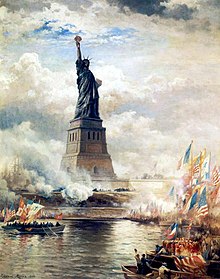
See also
- Index of United States-related articles
- Outline of the United States
- List of United States cities by population
- List of metropolitan areas of the United States
- List of official United States national symbols
- Template:Wikipedia books link
References
- ^ 36 U.S.C. § 302 National motto
- ^ Simonson, 2010
- ^ Dept. of Treasury, 2011
- ^ Cite error: The named reference
WFwas invoked but never defined (see the help page). - ^ "U.S. POPClock Projection". U.S. Census Bureau. (figure updated automatically).
- ^ a b c d "World Economic Outlook Database: United States". International Monetary Fund. 2013. Retrieved November 5, 2013.
{{cite web}}: Unknown parameter|month=ignored (help) - ^ "Income, Poverty and Health Insurance Coverage in the United States: 2011". Newsroom. United States Census Bureau. September 12, 2012. Retrieved January 23, 2013.
- ^ "Human Development Report 2013" (PDF). United Nations Development Programme. March 14, 2013. Retrieved March 14, 2013.
- ^ Cite error: The named reference
ILWwas invoked but never defined (see the help page). - ^ "Ecological Footprint Atlas 2010" (PDF). Global Footprint Network. Retrieved July 11, 2011.
- ^ "Cartographer Put 'America' on the Map 500 years Ago". USA Today. Washington, D.C. Associated Press. April 24, 2007. Retrieved November 30, 2008.
- ^ DeLear, Byron (July 4, 2013) Who coined 'United States of America'? Mystery might have intriguing answer. "Historians have long tried to pinpoint exactly when the name 'United States of America' was first used and by whom. A new find suggests the man might have been George Washington himself." Christian Science Monitor (Boston, MA).
- ^ "To the inhabitants of Virginia," by A PLANTER. Dixon and Hunter's Virginia Gazette #1287 – April 6, 1776, Williamsburg, Virginia. Letter is also included in Peter Force's American Archives Vol. 5
- ^ Carter, Rusty (August 18, 2012). "You read it here first"[dead link]. Virginia Gazette. "He did a search of the archives and found the letter on the front page of the April 6, 1776, edition, published by Hunter & Dixon."
- ^ DeLear, Byron (August 16, 2012). "Who coined the name 'United States of America'? Mystery gets new twist." Christian Science Monitor (Boston, MA).
- ^ Jefferson's "original Rough draught" of the Declaration of Independence
- ^ "The Charters of Freedom". National Archives. Retrieved June 20, 2007.
- ^ Mary Mostert (2005). The Threat of Anarchy Leads to the Constitution of the United States. CTR Publishing, Inc. p. 18. ISBN 9780975385142.
- ^ "Get to Know D.C." Historical Society of Washington, D.C. Retrieved July 11, 2011.
- ^ Wilson, Kenneth G. (1993). The Columbia Guide to Standard American English. New York: Columbia University Press, pp. 27–28. ISBN 0-231-06989-8.
- ^ Zimmer, Benjamin (November 24, 2005). "Life in These, Uh, This United States". University of Pennsylvania—Language Log. Retrieved January 5, 2013.
- ^ G. H. Emerson, The Universalist Quarterly and General Review, Vol. 28 (Jan. 1891), p. 49, quoted in Zimmer paper above.
- ^ For example, the U.S. embassy in Spain calls itself the embassy of the "Estados Unidos", literally the words "states" and "united", and also uses the initials "EE.UU.", the doubled letters implying plural use in Spanish [1] Elsewhere on the site "Estados Unidos de América" is used [2]
- ^ "Statue of Liberty". World Heritage. UNESCO. Retrieved October 20, 2011.
Bibliography
- Acharya, Viral V.; Cooley, Thomas F.; Richardson, Matthew P.; Walter, Ingo (2010). Regulating Wall Street: The Dodd-Frank Act and the New Architecture of Global Finance.
Wiley. p. 592. ISBN 978-0470768778. - Barth, James; Jahera, John (2010). "US Enacts Sweeping Financial Reform Legislation". Journal of Financial Economic Policy. 2 (3): 192–195. doi:10.1108/17576381011085412.
- Berkin, Carol; Miller, Christopher L.; Cherny, Robert W.; Gormly, James L. (2007). Making America: A History of the United States, Volume I: To 1877. Cengage Learning. p. 75., Book
- Bianchine, Peter J.; Russo, Thomas A. (1992). "The Role of Epidemic Infectious Diseases in the Discovery of America,
(Allergy and Asthma Proceedings)". 13 (5).
OceanSide Publications, Inc.: 225–232. doi:10.2500/108854192778817040. Retrieved September 9, 2012.{{cite journal}}: Cite journal requires|journal=(help) - Boyer, Paul S.; Clark, Cliffoed E. Jr.; Kett, Joseph F. (2007).
The Enduring Vision: A History of the American People. Cengage Learning. p. 588. ISBN 9780618801619.{{cite book}}: Unknown parameter|coauthors=ignored (|author=suggested) (help), Book - Clingan, Edmund. An Introduction to Modern Western Civilization. iUniverse. ISBN 9781462054398., Book
- Calloway, Colin G. New Worlds for All: Indians, Europeans, and the Remaking of Early America.
JHU Press. p. 229. ISBN 9780801859595., Book - Davis, Kenneth C. (1996). Don't know much about the Civil War. New York: William Marrow and Co. p. 518. ISBN 0-688-11814-3., Book
- Daynes, Byron W.; Sussman, Glen (eds.) (2010). White House Politics and the Environment: Franklin D. Roosevelt to George W. Bush.
Texas A&M University Press. p. 320. ISBN 9781603442541.Presidential environmental policies, 1933–2009
{{cite book}}:|first2=has generic name (help), Book - Feldstein, Sylvan G.; Fabozzi, CFA, Frank J. The Handbook of Municipal Bonds.
John Wiley & Sons, Jan 13, 2011. p. 1376. ISBN 9781118044940., Book - Gold, Susan Dudley (2006). United States V. Amistad: Slave Ship Mutiny.
Marshall Cavendish. p. 144. ISBN 9780761421436., Book - Ferguson, Thomas; Rogers, Joel (1986). "The Myth of America's Turn to the Right". The Atlantic. 257 (5): 43–53. Retrieved March 11, 2013.
- Fraser, Seve; Gerstle, Gary (1989). The Rise and Fall of the New Deal Order: 1930–1980. American History: Political science.
Princeton University Press. p. 311. ISBN 9780691006079. - Gordon, John Steele (2004). An Empire of Wealth: The Epic History of American Economic Power. HarperCollins., Book
- Graebner, Norman A.; Burns, Richard Dean; Siracusa, Joseph M. (2008). Reagan, Bush, Gorbachev: Revisiting the End of the Cold War. Praeger Security International Series.
Greenwood Publishing Group. p. 180. ISBN 9780313352416. - Hughes, David (2007). The British Chronicles. Vol. 1. Westminister, Maryland:
Heritage Books. p. 347. - Jacobs, Lawrence R. (2010). Health Care Reform and American Politics: What Everyone Needs to Know: What Everyone Needs to Know.
Oxford University Press. ISBN 9780199781423. - Johnson, Paul (1997). A History of the American People. HarperCollins. pp. 26–30., eBook version
- Juergens, Tom (2011). Wicked Puritans of Essex County.
The History Press. p. 112. ISBN 9781596295667., Book - Kessel, William B.; Wooster, Robert (2005). Encyclopedia of Native American Wars and Warfare. Facts on File library of American History.
Infobase Publishing. p. 398. ISBN 9780816033379., Book - Kolko, Gabriel (1988). Confronting the Third World: United States Foreign Policy, 1945–1980. New York, NY: Pantheon.
{{cite book}}: Invalid|ref=harv(help) - Leckie, Robert (1990). None died in vain: The Saga of the American Civil War. New York: Harper-Collins. p. 682. ISBN 0-06-016280-5., Book
- Leffler, Melvyn P. (2010). "The emergence of an American grand strategy, 1945–1952".
In Melvyn P. Leffler and Odd Arne Westad, eds.,The Cambridge History of the Cold War, Volume 1: Origins (pp. 67–89).
Cambridge: Cambridge University Press. ISBN 978-0-521-83719-4.{{cite book}}: Invalid|ref=harv(help) - Lemon, James T. (1987). "Colonial America in the 18th Century". In Robert D. Mitchell; Paul A. Groves (eds.). North America: the historical geography of a changing continent. Rowman & Littlefield., PDF
- Lien, Ph.D, Arnold Johnson (1913). Studies in History, Economics, and Public Law, Volume 54. Longmans, Green & Co., Agents, London; Columbia University, New York. p. 604.
- Karen Wood Weierman (2005). One Nation, One Blood: Interracial Marriage In American Fiction, Scandal, And Law, 1820–1870.
University of Massachusetts Press. p. 214. ISBN 978-1-55849-483-1., Book - Levenstein, Harvey (2003). Revolution at the Table: The Transformation of the American Diet.
University of California Press, Berkeley, Los Angeles. ISBN 0-520-23439-1. - Mann, Kaarin (2007). "Interracial Marriage In Early America: Motivation and the Colonial Project" (PDF). Michigan Journal of History (Fall).
University of Michigan. Retrieved September 8, 2012. - Price, David A. (2003). Love and Hate in Jamestown: John Smith, Pocahontas, and the Start of a New Nation. Random House. eBook version
- Quirk, Joel (2011). The Anti-Slavery Project: From the Slave Trade to Human Trafficking.
University of Pennsylvania Press. p. 344. ISBN 978-0-8122-4333-8., Book - Ranlet, Philip (1999). Alden T. Vaughan (ed.). New England Encounters: Indians and Euroamericans Ca. 1600–1850.
North Eastern University Press. - Rausch, David A. (1994). Native American Voices.
Baker Books, Grand Rapids. p. 180., Book - Remini, Robert V. (2007). The House: The History of the House of Representatives. HarperCollins. pp. 2–3., Book
- Ripper, Jason (2008). American Stories: To 1877.
M.E. Sharpe. p. 299. ISBN 9780765629036., Book - Russell, John Henderson (1913). The Free Negro in Virginia, 1619–1865. Johns Hopkins University. p. 196., E'Book
- Schneider, Dorothy; Schneider, Carl J. (2007). Slavery in America. Infobase Publishing. p. 554. ISBN 9781438108131., Book
- Schultz, David Andrew (2009). Encyclopedia of the United States Constitution.
Infobase Publishing. p. 904. ISBN 9781438126777., Book - Simonson, Peter (2010). Refiguring Mass Communication: A History. Urbana: University of Illinois Press. ISBN 9780252077050.
He held high the Declaration of Independence, the Constitution, and the nation's unofficial motto, e pluribus unum, even as he was recoiling from the party system in which he had long participated.
, Book - Smith, Andrew F. (2004). The Oxford Encyclopedia of Food and Drink in America.
New York: Oxford University Press, pp. 131–32. ISBN 0-19-515437-1. - Soss, Joe (2010). Hacker, Jacob S.; Mettler, Suzanne (eds.). Remaking America: Democracy and Public Policy in an Age of Inequality.
Russell Sage Foundation. ISBN 9781610446945., Book - Tadman, Michael (2000). The Demographic Cost of Sugar: Debates on Slave Societies and Natural Increase in the Americas. Vol. 105. Oxford University Press.
{{cite book}}:|journal=ignored (help), Article - Taylor, Alan (2002). Eric Foner (ed.). American Colonies: The Settling of North America. Penguin Books, New York. ISBN 0-670-87282-2., Book
- Thornton, Russell (1987). American Indian Holocaust and Survival: A Population History Since 1492. Volume 186 of Civilization of the American Indian Series.
University of Oklahoma Press. p. 49. ISBN 9780806122205., Book - Tooze, Adam (2006). The Wages of Destruction: The Making and Breaking of the Nazi Economy.
London: Allen Lane. ISBN 978-0-713-99566-4.{{cite book}}: Invalid|ref=harv(help) - Vaughan, Alden T. (1999). New England Encounters: Indians and Euroamericans Ca. 1600–1850.
North Eastern University Press. - Walton, Gary M.; Rockoff, Hugh (2009). History of the American Economy. Cengage Learning., Book
- Williams, Daniel K. (2012). "Questioning Conservatism's Ascendancy: A Reexamination of the Rightward Shift in Modern American Politics; {Reviews in American History}" (PDF). 40 (2).
The Johns Hopkins University Press: 325–331. doi:10.1353/rah.2012.0043. Retrieved March 11, 2013.{{cite journal}}: Cite journal requires|journal=(help) - Zinn, Howard (2005). A People's History of the United States. HarperCollins. ISBN 0060838655.
Website sources
- "Country Profile: United States of America". BBC News. London. April 22, 2008. Retrieved May 18, 2008.
- Cohen, Eliot A. (July/August 2004). "History and the Hyperpower". Foreign Affairs. Washington D.C. Retrieved July 14, 2006.
{{cite web}}: Check date values in:|date=(help) - "Slavery and the Slave Trade in Rhode Island".
- "Peopling of Americas". Smithsonian Institution, National Museum of Natural History. 2004. Archived from the original on November 28, 2007. Retrieved June 19, 2007.
{{cite web}}: Unknown parameter|month=ignored (help) - "History of "In God We Trust"". U.S. Department of the Treasury. March 8, 2011. Retrieved February 23, 2013.
- "Early History, Native Americans, and Early Settlers in Mercer County". Mercer County Historical Society. 427. Archived from the original on April 15, 2013., Book
- Nick Hayes (November 6, 2009). "Looking back 20 years: Who deserves credit for ending the Cold War?". MinnPost. Retrieved March 11, 2013.
- "59e. The End of the Cold War". U.S. History.org. Independence Hall Association. Retrieved March 10, 2013.
- Levy, Peter B. (1996). Encyclopedia of the Reagan-Bush Years. ABC-CLIO. p. 442. ISBN 9780313290183.
- Wallander, Celeste A. (2003). "Western Policy and the Demise of the Soviet Union". Journal of Cold War Studies. 5 (4). President and Fellows of Harvard College and the Massachusetts Institute of Technology: 137–177. doi:10.1162/152039703322483774. Retrieved March 11, 2013.



